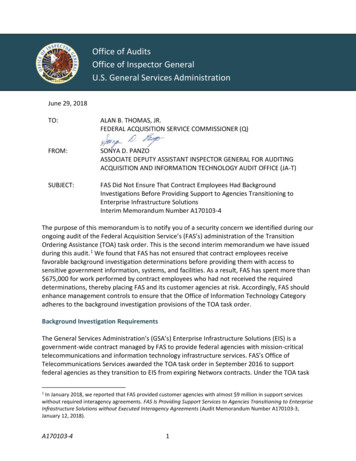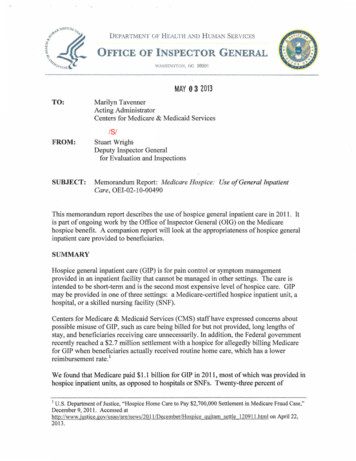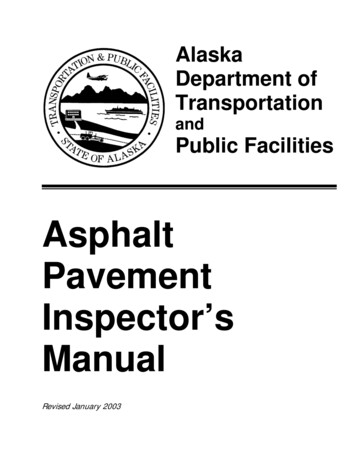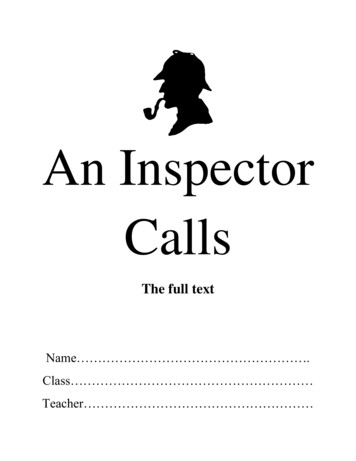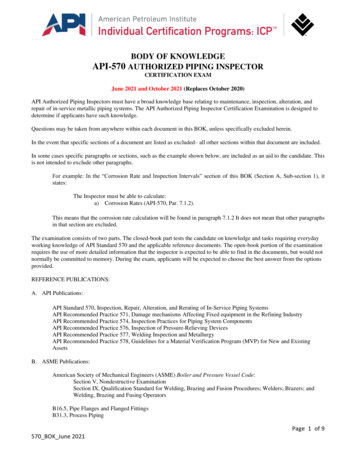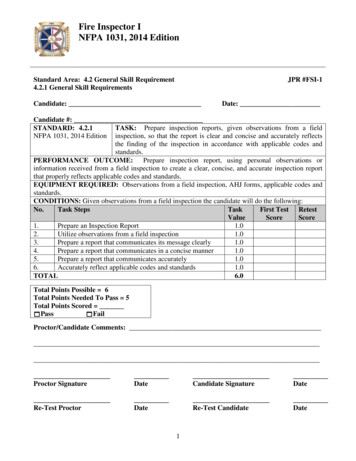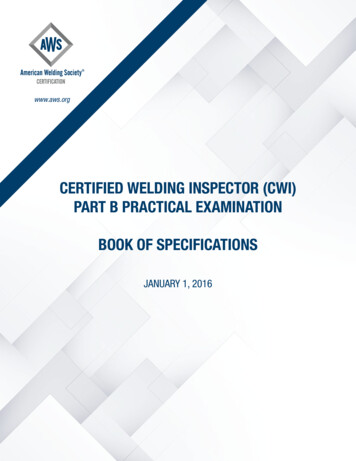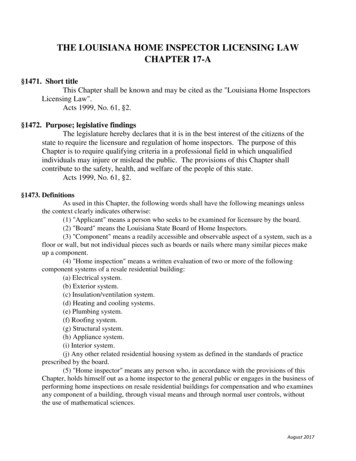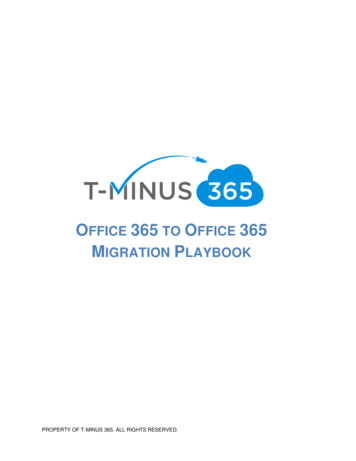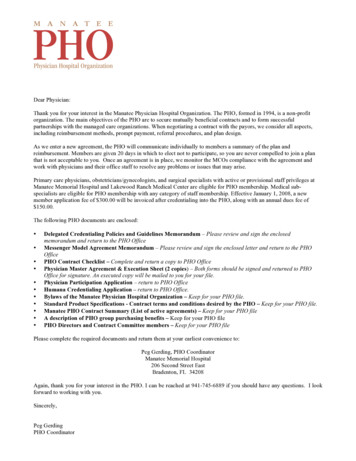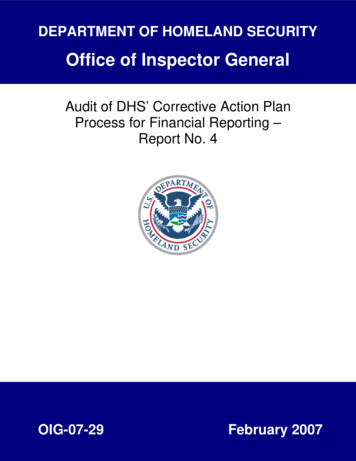
Transcription
DEPARTMENT OF HOMELAND SECURITYOffice of Inspector GeneralAudit of DHS’ Corrective Action PlanProcess for Financial Reporting –Report No. 4OIG-07-29February 2007
KPMG LLP2001 M Street, NWWashington, DC 20036January 17,2007Mr. David ZavadaAssistant Inspector General for AuditDepartment of Homeland Security245 Murray Drive, SW Bldg. 410Washington, DC 20258Mr. David NorquistChief Financial OfficerDepartment of Homeland Security245 Murray Drive, SW Bldg. 410Washington, DC 20258KPMG LLP is pleased to submit this performance audit report related to several of the UnitedStates Coast Guard's finanical improvement activities. The activities were designed to addressmaterial weaknesses reported in the Department of Homeland Security's (the Department)independent auditors' report included in the fiscal year 2005 Performance and AccountabilityReport. Our audit included an evaluation of:The integrity of four Corrective Action Plans (CAPS) - Entity-Level Controls, FinancialReporting, Fund Balance with Treasury, and Actuarial Liabilities updated as ofSeptember 30, 2006.How well five contractor support plans align to address material weaknesses related tofinancial system improvement, project management, internal control policy developmentand testing, and financial reporting review and generally accepted accounting principles(GAAP) compliance.The status of the Financial Management Transformation and CFO Audit RemediationPlans defined in the memorandum dated July 3, 2006, from Commandant Thad Allen toCG-8.This performance audit is the fourth of a series of performance audits that the Department'sOffice of Inspector General has engaged us to perform for fiscal year 2006. This performanceaudit is designed to meet the objectives identified in the Background, Objectives, and Scopesection of this report.We conducted this performance audit from October 10, 2006 to November 3,2006, in accordancewith Government Auditing Standa *ds,issued by the Comptroller General of the United States.The purpose of this report is to communicate the results of our performance audit and the relatedfindings and recommendations.
Since November 3, 2006, we have not performed any additional procedures with respect to thisperformance audit and have no obligation to update this report or to revise the informationcontained herein to reflect events occurring subsequent to November 3, 2006.The Department's Office of Inspector General has authorized this report to be sent electronicallyfor the convenience of the Department. However, only the final hard copy of our report should bedeemed our work product.
Executive SummaryObjectiveThe Department's Office of Inspector General (OIG) requested a performance audit to evaluatethe United States Coast Guard's (Coast Guard) development of four CAPs, the alignment ofcontractor support activities to the resolution of material weaknesses in financial reporting, andthe status of the development of a strategic plan for financial management transformation, asdirected by the Commandant's Intent Action Order #5 (the Order) dated July 3,2006.OverviewThe Coast Guard undertook a number of activities, including the development of CAPs,engagement of contractors, and issuance of internal directives, in an effort to resolve materialweaknesses in financial reporting.aThe Coast Guard has drafted four CAPS to address material weaknesses in financial reportingrelated to Entity-Level Controls, Financial Reporting, Fund Balance with Treasury, and ActuarialLiabilities. The Department deems these CAPS to be critical steps towards its objective ofobtaining an unqualified audit opinion on its consolidated financial statements, as well as on itsintern1 controls over financial reporting. The CAPS were developed in the final months of fiscalyear 2006 by the respective process owners and were to include the identification of root causesof the material weakness, key success factors, key performance measures, verification andvalidation, risks, and resources requirements.Additionally, to assist in the implementation of the CAPS and the resolution of the materialweaknesses, the Coast Guard awarded five contracts in August 2006 and September 2006, asfollows:Deloitte Consulting, LLP (Deloitte) for project management and financial managementsupport services.Okoye & Associates, LLC (Okoye) for internal control policy development and test plandevelopment for compliance with internal control over financial reporting.PricewaterhouseCoopers, LLP (PwC) for financial reporting assistance, assistance inpolicy development, and compliance with guidance and regulations such as generallyaccepted accounting principles (GAAP), Federal Managers Financial Integrity Act(FMFIA), and Federal Financial Management Improvement Act (FFMIA).Global Computer Enterprises, Inc. (GCEI) for financial system audit remediation supportfocused on financial system security [two contracts].Finally, Commandant Allen issued the Commandant's Order, which directed the establishment ofa team to plan for transformation of the Coast Guard's financial management organization into amodel of excellence. Accordingly, in July 2006, the Coast Guard chartered the FinancialManagement Transformation Task Force (FMTTF) with providing short-term win plans and along(er)-term strategic plan of action and milestones (POAM) to advance the goal of earningsustainable, clean audit opinions.
ApproachOur assessment of the integrity of the Coast Guard CAPs (as of September 30,2006) focused onan evaluation of the following CAP elements:Identification of the underlying root cause(s)Development of an effective remediation planAccountabilitv for establishing and successfully implementing the CAPValidation of the successful implementation of the CAP.The CAPs were the subject of three previous performance audits. Accordingly, we considered therevisions made to them since the last performance audit.Our assessment of the contracts focused on how well they aligned with efforts necessary toresolve the Coast Guard's material weaknesses. Specifically, we reviewed the methods used indeveloping the performance work statement (PWS) and their relationship to the materialweaknesses.With respect to the Commandant's Order, our assessment focused on the identification ofactivities taken in response to the Order (six actions). However, the timing of our reviewcoincided with the commencement of activities resulting from that order, and therefore, theintended outcomes of the execution of the Order have not yet been fully achieved.Our performance audit did not assess whether the CAPs, contracting actions, or actions taken inresponse to the Commandant's Order will resolve the respective material weaknesses.Summary of Key ObservationsDuring the course of the performance audit, we observed some underlying elements that werecommon among all objectives. Those elements are described below. Additional observationsspecific to a particular area of the performance audit are included within the Background,Findings, and Recommendations sections of this report.Coordination of EffortsThe Coast Guard did not effectively coordinate its various remediation activities. It appears thatthe development and update of the CAPs, the development of the PWSs for the contracts, and thePOAM were done concurrently and independent of each other. The activities were not adequatelycoordinated to form a single cohesive/comprehensive plan. In addition, there does not appear tobe a single point of authority to coordinate the integration of remediation efforts and providestrategic oversight of each of these endeavors to help ensure that plans are coordinated and effortsare not duplicated.For example, both the CAP process owners and the FMTTF performed a root cause analysis.However, the work products of the FMTTF have not been integrated into the revised CAPs. Inanother example, the FMTTF has createdlwill create short-term plans to resolve select materialweaknesses. These plans were described as supplements to the CAPs; however, these plans havenot been included in the revised CAPs.
Coast Guard management believes that the remediation of the material weaknesses will requirecompletion of the action steps contained in the short-term plans, the milestones included in theCAPs, and the steps outlined in the long-term plan (the POAM). To reduce the likelihood thatefforts are duplicated or that gaps do not exist in the plans, efforts will need to be coordinated andintegrated.Root Cause Analysis, Plan Development, and VerificationWalidationThe CAPs and the FMTTF POAM would benefit from detailed definitions and process-levelanalysis (e.g., A-123 analysis) of the underlying root causes of the material weaknesses. Whilethese plans identified high-level "causes", they have not fully contemplated an assessment of thebusiness processes and information systems that drive the transactions/activities giving rise to thematerial weaknesses. Implementing corrective actions without first determining whether allsignificant deficiencies affecting management's ability to support their financial reporting havebeen identified may risk missing some of the deficiencies and their underlying cause(s) and resultin potential wasted time. For example, the Coast Guard has planned to adopt the "TSA generalledger platform" as part of the resolution to the Financial Reporting material weakness. Without athorough analysis to determine all of the deficiencies and limitations of the current general ledger,the Coast Guard risks implementing a "solution" that may not resolve all deficiencies and thus therelated material weaknesses.-&In addition, the Coast Guard has not defined procedures to assess the effectiveness of itsremediation activities. The CAPs, contracts, and POAM did not contain activities for validatingthe effectiveness of the plans. While the plans did include goals, tasks, and milestones, they didnot include an evaluation process to determine whether the material weaknesses have beenresolved. However, the Coast Guard did indicate that such a process would be developed by theircontractors.Contract OversightThe Coast Guard requires human resources to effectively execute and provide oversight for theexecution of remediation activities. The Coast Guard is constrained both by low head count andby the lack of personnel with deep financial management and project management experience andcapabilities. For example, although the Coast Guard has established overall accountability for theCAPs at a senior level, they have not assigned accountability for specific tasks at a detailed level.Coast Guard management stated that the resources to performloversee these tasks are currentlynot available. Furthermore, the shortage of qualified staff, including a designated leader, isimpairing the Coast Guard's ability to continue the transformation efforts of the FMTTF. As aresult, the Financial Reengineering team is not fully fielded to assist with carrying out FMTTFactivities/actions.In response to these resource constraints, the Coast Guard has turned to contractors to assist in theremediation efforts. While the use of contractors helps alleviate the resource constraints, thereappears to be an inadequate number of experienced and trained government staff to oversee thework. For example, the oversight of the estimated 150 contractors in the Financial SystemsDivision is shared among six Coast Guard staff. In addition, the government personnel providingoversight for the contracts do not have the credentials or experience in financial managementoversight of complex organizations to direct or evaluate the quality of the work provided by thecontractors.
Summary of Key RecommendationsDuring the course of the performance audit, we formed several recommendations related to ourobservations above. Additional recommendations specific to a particular area of the performanceaudit are included within the Background, Findings, and Recommendations sections of thisreport. Specifically, the Coast Guard should:Coordination of Efforts1) Develop a consolidated and comprehensive plan for all remediation activities and/or integratethe plan with other internal control assessment and remediation initiatives (e.g., OMBCircular A-123). The remediation plan should include:The incorporation of the POAM, the CAPs, and all subsequent actions performed to assistwith remediation planning to form a single unified plan for all efforts and determinewhether any current efforts, to include Lean Six Sigma implementation, should becontinued, curtailed, or stopped.Work breakdown structures for each root cause once they are identified and validated.The work breakdown structures should include a detailed set of activities that include theprocess-level activities that must be addressed to resolve the issue, the individuals-- responsible for implementing the activities, the level of effort required by each individualto implement the activities, and detailed timelines with intermediate milestones formonitoring and reporting on work completed.2) Identify a designated Coast Guard "owner" or senior-level executive (e.g., DCFO)responsible for integrating and coordinating all financial management and reportingimprovement initiatives. The owner should implement a process for integrating the contractorsupport efforts, FMTTF activities, and CAP updates. Such coordination and integration isneeded to avoid duplicating remediation efforts and for reducing the likelihood of costlycontract modifications.Root Cause Analysis, Plan Development, and VerificationNalidation3) Utilize existing contract support to review the identification of root causes for the CAPs andthe analysis prepared to support the development of the remediation plans. The Coast Guardshould develop detailed crosswalks for mapping root causes, related audit findings, andrecommendations to address each material weakness. Further, the Coast Guard shouldundertake an independent validation and verification to determine whether the root causeslisted in the CAPs are complete and adequately aligned to address the material weaknesses.4) Develop a risk-based approach for prioritizing activities and establishing the critical paths forresolving identified weaknesses. The Coast Guard should use materiality or business-riskanalysis methodologies to identify high-value areas and prioritize efforts (e.g., use materialityto determine financial statement line items to take action in the near term).Contract Oversight5) Implement the navigational dashboard being developed by the PMO to standardize thereporting and tracking functions and define the criteria for evaluating percentage tocompletion of CAP activities.
6) Ensure that resource requirements are identified, aligned, and in place to implement theCAPs. This will require the Coast Guard to ensure that all resource requirements are either inthe budget for hiring or provided to the appropriate human resources personnel for rotationsor reassignments within the Department. Alternative staffing models should be used in thenear term until resources have been secured. Example alternative staffing models couldinclude the use of detailees andlor long-term rotational assignments of Coast Guard orDepartment personnel.7) Provide Coast Guard personnel to oversee contracting efforts, evaluate work products, andmonitor compliance with the SOWS. The Coast Guard must assemble an adequately trainedand credentialed government staff that is sufficient in size to supervise all contractorperformance. The staff should have the requisite knowledge and experience to direct andevaluate the quality of contractor work products.Background, Objectives, and ScopeBackgroundOff of Management and Budget (OMB) Circular A-123, Management's Responsibility forInternal Control, states "Federal agencies are subject to numerous legislative and regulatoryrequirements that promote and support effective internal control. Effective internal control is akey factor in achieving agency missions and program results through improved accountability.Identifying internal control weaknesses and taking related corrective actions are criticallyimportant to creating and maintaining a strong internal control infrastructure that supports theachievement of agency objectives."OMB Circular A-123 builds upon the internal control framework within the Standards forInternal Control in the Federal Government (Green Book), issued by the U.S. GovernmentAccountability Office (GAO), which defines internal control as "an integral component of anorganization's management that provides reasonable assurance that the following objectives,effectiveness and efficiency of operations; reliability of financial reporting; and compliance withapplicable laws and regulations are being achieved."Ten material weaknesses associated with internal controls were reported in the Department'sindependent auditors' report included in the fiscal year 2005 Performance and AccountabilityReport. The Department has undertaken an initiative to develop and implement a formal CAPprocess. Under this initiative, the Department has issued guidance and has deployed a Web-basedsoftware application, Electronic Program Management Office (ePMO), to manage the collectionand reporting of CAP information for the Department and its components. Under this initiative,the Department's intent is to develop effective CAPs and position itself to move forward in itsobjective of obtaining an unqualified audit opinion on its consolidated financial statements, aswell as on its internal controls over financial reporting.The first key milestone in the Department's CAP process required all components to developCAPs for each material weakness and to submit them for input into ePMO by the Department'sOffice of the Chief Financial Officer (OCFO) by May 31,2006. The second key milestone was tosubmit revisions of the revised June 30, 2006, CAPs by July 12, 2006. Additionally, beginning inJuly 2006, each CAP was required to be updated within ePMO by the last day of each month.
The September 30,2006, CAPs were used as the basis of our performance audit.ObjectivesThis performance audit has three main objectives: (1) assess the integrity of the CAPs, updated asof September 30, 2006, related to 4 of the 10 material weaknesses that were cited in theindependent auditors' report; (2) evaluate the alignment of 5 contracts awarded to support actionsto correct specific material weaknesses; and (3) evaluate the Financial ManagementTransformation and CFO Audit Remediation task force activities taken in response to theCommandant's Order issued July 3,2006.Our performance audit was conducted in accordance with Government Auditing Standards, issuedby the Comptroller General of the United States, specifically, the standards for performanceaudits.ScopeThe scope of our work included evaluating the integrity of the following CAPs updated as ofSeptember 30,2006:-AEntity-Level ControlsFinancial ReportingFund Balance with TreasuryActuarial LiabilitiesAdditionally, the scope included an assessment of how well the following contractor supportplans aligned with efforts necessary to resolve the Coast Guard's material weaknesses:Deloitte, for project management and financial management support servicesOkoye, for internal control policy development and test plan developmentPwC, for financial reporting review and GAAP compliance reviewGCEI, for financial system audit remediation support [two contracts]Finally, our scope included a review of the FMTTF activities to assess if milestones had been metas outlined in the Commandant's Order.Our scope did not include procedures on any of the CAPS associated with any of the othermaterial weaknesses cited in the Department's fiscal year 2005 independent auditors' report.Furthermore, our performance audit did not address the outcomes achieved as a result of theexecution of the CAPs, contracting actions, or Commandant's Order, or the status of the materialweaknesses.The
Management Transformation Task Force (FMTTF) with providing short-term win plans and a long(er)-term strategic p
